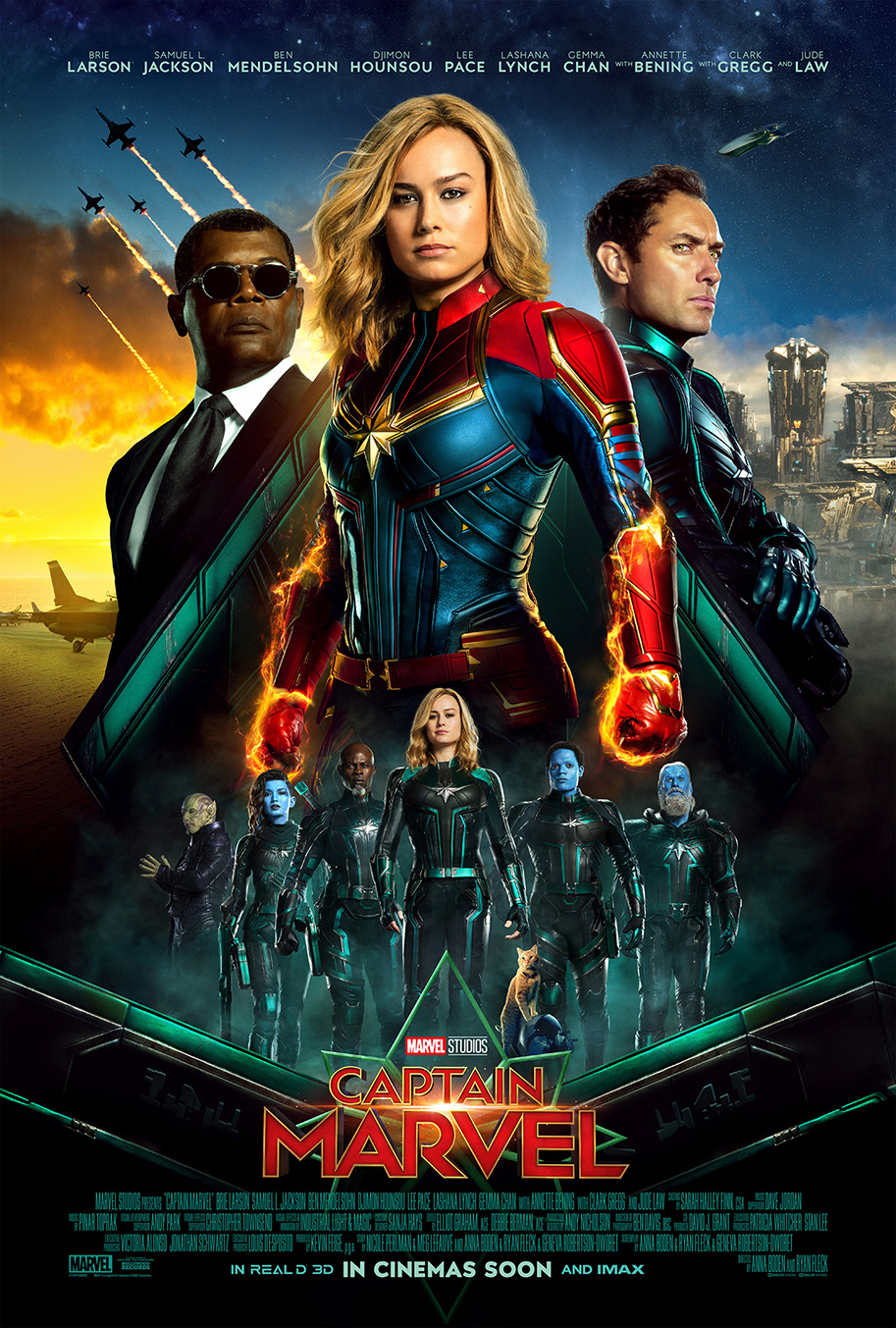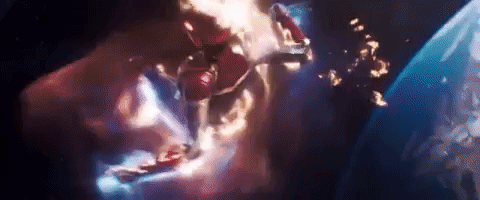
“Thank you, Stan.”
Captain Marvel’s opening montage, a collection of Stan Lee portraits set against the Marvel Studios logo, is a poignant and meaningful dedication to an iconic personality who was partly responsible for giving popular culture a bevy of iconic characters with abilities as diverse as their backgrounds. They’re joined by Carol Danvers, an amnesiac Air Force pilot who is one of the Kree, a civilization of noble warriors (not to be confused with the First Nations group known as the Cree) battling against the Skrull, a race of shapeshifting beings who have invaded countless worlds.
Captain Marvel, notably very rarely referred to as such, is an origin story that feels immensely self-aware of its pedigree almost to a fault, with significant portions of the film feeling slapped together and rapidly edited as if to say, “The audience has seen this before, but the story can’t exist without it.” This punctuates the whole film and keeps it from being its same-named studio’s finest offering, but the film is bolstered by existing almost completely independently of its own controversy, never coming across as insulting or demeaning any portion of its audience even in the name of girl power. Also importantly, star Brie Larson brings her A-game and is backed up by an enjoyable and frequently funny supporting cast, who bring more warmth than the enjoyable but unintentionally disturbing story might suggest.
Captain Marvel’s most blatant feature, and probably the one I expect to divide audiences the most, is its uncoventional and even messy approach to storytelling—important events are usually relayed out of order or with information missing, as the audience slowly pieces together Carol Danvers’ true identity and history at the same time that she herself does. This slapdash pacing keeps her origin story and its structure from feeling too rote and familiar, but it also makes its own sequence of events hard to follow and gets in the way of its characterization (the story’s best and most defining asset). We’re introduced to “Vers”—pronounced veers—as well as her home, a technologically advanced, densely populated alien world called Hala, her allies, and her Skrull enemies in an abrupt fashion that almost feels like a music video.
Hala, though gorgeous, gets hardly any screen time, and it isn’t nearly as elaborately developed or explained as was the immensely memorable setting of Wakanda in last year’s Black Panther. What little we know is that Vers and all of her society answer to a godlike AI known as the Supreme Intelligence, who interfaces with its users via sentient-seeming cords that look like they came out of James Cameron’s Avatar. After this, she and several of her friends stage a deep-space rescue mission for one of their own, which is visually harder to follow than it should be because of how dim it is. Friends, enemies, and weapons flash in front of the camera, with few elements being clearly visible, never mind distinctive, other than characters unfortunate enough to be illuminated by a gun sight. It’s not long before the operation goes awry, and Vers becomes separated, is sent hurtling through space … and ends up crashing through a Blockbuster Video.

It’s the ’90s all over again, and Marvel’s done an impressive job of replicating an aesthetic much of its audience will vividly remember—the Game Boy is being advertised, AltaVista is a prominent search engine, pay phones are readily available, the cars look like boxy clunkers, and uploading data from a CD-ROM takes forever. (Where does Vers get sent to when she’s looking for communications equipment to contact her people with? Radio Shack, of course.) In a moment that goes by so quickly that it’s possible I imagined it, there’s a split-second scene that takes place in front of a comic shop, and I’m pretty sure I saw a flash of Wonder Woman. The film does an impressive job of avoiding anachronisms even as it plays with military aviation technology including a jet that can travel to space.
Vers’ “introduction” to Earth, while not without its oddities (she blatantly steals a man’s motorcycle, seemingly without consequences), is quickly made interesting thanks to a plot involving a younger Nick Fury and Phil Coulson, exciting car chases and gun fights, and shapeshifting enemies, but the complex plot logistics are kept in the background while Brie Larson’s and Samuel L. Jackson’s likable comedic antics take center stage. There’s even a cute cat!
The problem is that while the story has an interesting, Matrix-resembling premise—anyone you know and love could be an alien spy—the film seems to drop this angle when it becomes inconvenient except for making the most of its inherent tension. Instead of a standard romantic interest, Carol Danvers displays most of her humaneness in interacting with a young mother and her daughter (the film sails over racial contexts in much the same way that Wonder Woman avoided sexism subplots). These make for touching scenes, but emotional vulnerability is a dangerous game in a story whose number-one rule is that anyone could be an enemy, a tension that the film does well with for a few scenes but ultimately feels like it could have explored more thoroughly. One Skrull character is shown to be emotionally close to his family at one point: How do Skrull maintain strong family bonds in a society where masquerading as someone else would be very easy, never mind when enormous interstellar distances become a factor as they do here? (This even raises questions of the trustworthiness of characters within the greater Marvel universe, a problem this movie doesn’t seem to be aware of. Forget Hydra: what if Tony Stark was a shapeshifting impostor? How would Loki respond?)
There is a subtext of sexism within the obstacles that Danvers must overcome—“you’re too emotional”—but its specific context more closely resembles an alien, Vulcan-like/almost pragmatic urge for her to control her powers, lest they control her. The story does a good job of avoiding undertones that demonize either sex, however, as men and women often find themselves on the sides of both heroes and villains, with no running pattern (contrast something like Aliens). However, the villains that the plot does showcase are rarely given deep characterizations, with the most notable exception really not even counting as a “villain,” and many of these people, despite their interesting if very Star Trek-esque character designs, aren’t even addressed by name. We’re meant to cheer when one of the villains meets her end, but we’ve hardly seen her for very much of the film.
I really think the story’s component parts are smarter than plot realizes them to be, but because of this, Captain Marvel doesn’t always explore its own implications. Larson plays Danvers as being cocky and sometimes patronizing; I found this entertaining but can understand how it would be off-putting. Because her character endured such treatment from similar personalities in her youth, however, it sends the message that Danvers is possibly unintentionally transferring her own negative experiences into how she sometimes treats other people.

The production values work well for the film but aren’t really its highlight: The original music is rousing, but not particularly distinct. Explosions and fire blasts look fine, and other than the very dark stealth scene that really gets the film going, the visual effects’ only real shortcoming is that one of the unusual-looking aircraft Danvers flies tends to look a bit wobbly. A shot of Danvers in a hangar, preserved in a steelbook and stylized during the visually appealing closing credits, is among the film’s most memorable moments, possibly because it feels so distinct for her specific story since not every Marvel hero used to be an Air Force pilot. As far as the licensed music goes, the pleasant 1990s soundtrack feels like a more muted version of a Guardians of the Galaxy, but the absence of Nine Inch Nails feels inexplicable since Larson spends much of the film wearing one of their T-shirts.
This isn’t really a spoiler, but the story’s “been there, done that” degree of self-awareness works against it late in the film when one character literally begins shouting storytelling/genre cliches at both Danvers and effectively the audience. Likewise, many of Danvers’ memories tend to return at the precise moment when she needs them the most, which I expect audiences will either accept, because it’s fun, or won’t, because it’s so convenient. But the story feels like a wild variety of aesthetics—an advanced society whose strikingly impressive breadth was probably limited by real-world budget restrictions; a throwback to the world of 25 years ago; cutting-edge military technology; and familial bonding in the middle of the woods. This isn’t as thematically jarring or mismatched as something like Looper, which also presented an impressively depicted but underutilized future and then resolved much of its story elsewhere.
Conclusion: A fun film that sacrifices risk and innovation for the sake of its franchise.

It wouldn’t do for Marvel to purposely risk alienating viewers right before Avengers: Endgame, and that’s not substantially what happens here: Though Captain Marvel’s structure and themes seem highly questionable, the film knows how to respect its audience, including men, and including viewers who aren’t interested in popcorn entertainment being used for political propaganda. Other than short “you can’t do it” montages, there are no lectures about sexism or racism (there’s a brief, funny joke made at Nick Fury’s expense, but it comes across more as taking advantage of him being Nick Fury than of him being a man), and what you expect from the genre is more or less what you get, albeit jumbled up and at times scarcely recognizable.
Image sources, property of Walt Disney Pictures and Marvel Studios
– Movie poster (source)
– Danvers in airplane (source)
– Blasting through space (source)
– Looking furious (source)
This post was written and published for my review blog, Projected Realities.






